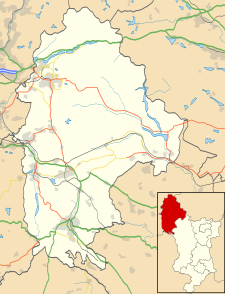
Duke of Devonshire is a title in the Peerage of England held by members of the Cavendish family. This branch of the Cavendish family has been one of the wealthiest British aristocratic families since the 16th century and has been rivalled in political influence perhaps only by the Marquesses of Salisbury and the Earls of Derby.

Buxton is a spa town in the Borough of High Peak, Derbyshire, in the East Midlands region of England. It is England's highest market town, sited at some 1,000 feet (300 m) above sea level. It lies close to Cheshire to the west and Staffordshire to the south, on the edge of the Peak District National Park. In 1974, the municipal borough merged with other nearby boroughs, including Glossop, to form the local government district and borough of High Peak.

William Cavendish, 5th Duke of Devonshire,, was a British nobleman, aristocrat, and politician. He was the eldest son of William Cavendish, 4th Duke of Devonshire, by his wife, the heiress Lady Charlotte Boyle, suo jure Baroness Clifford, who brought in considerable money and estates to the Cavendish family. He was invited to join the Cabinet on three occasions, but declined each offer. He was Lord High Treasurer of Ireland and Governor of Cork, and Lord Lieutenant of Derbyshire. In 1782, he was made a Knight of the Order of the Garter.

William Cavendish, 7th Duke of Devonshire,, styled as Lord Cavendish of Keighley between 1831 and 1834 and known as The Earl of Burlington between 1834 and 1858, was a British landowner, benefactor, nobleman, and politician.

Edward William Spencer Cavendish, 10th Duke of Devonshire,, known as the Marquess of Hartington from 1908 to 1938, was a British politician. He was the head of the Devonshire branch of the House of Cavendish. He had careers with the army and in politics and was a senior freemason. His sudden death, apparently of a heart attack at the age of fifty-five, occurred in the presence of the suspected serial killer John Bodkin Adams.
Peregrine Andrew Morny Cavendish, 12th Duke of Devonshire, is an English peer. He is the only surviving son of Andrew Cavendish, 11th Duke of Devonshire and his wife, the former Deborah Mitford. He succeeded to the dukedom following the death of his father on 3 May 2004. Before his succession, he was styled Earl of Burlington from 1944 until 1950 and Marquess of Hartington between 1950 and 2004. His immediate family are owner-occupiers of Chatsworth House and are worth an estimated £905 million. Estates landscaped before 1900 by the family are parts of Derbyshire and North Yorkshire. Other capital managed by the Duke includes fine and contemporary art, forestry and farming.

The University of Derby, formerly known as Derby College, is a public university in the city of Derby, England. It traces its history back to the establishment of the Derby Diocesan Institution for the Training of Schoolmistresses in 1851. It gained university status in 1992.
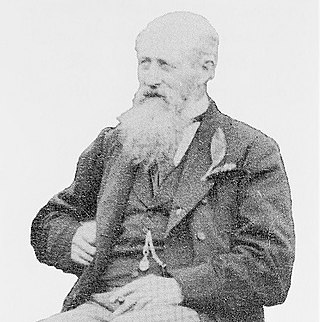
Robert Rippon Duke was an English architect and surveyor who designed various prominent Victorian buildings in Buxton, Derbyshire.

Peak Forest is a small village and civil parish on the main road the (A623) from Chapel-en-le-Frith to Chesterfield in Derbyshire. The population of the civil parish at the 2011 census was 335.

The Devonshire Dome building is a Grade II* listed 18th-century former stable block in Buxton, Derbyshire. It was built by John Carr of York and extended by architect Robert Rippon Duke, who added what was then the world's largest unsupported dome, with a diameter of 44.2 metres (145 ft). It is now the site of the Buxton Campus of the University of Derby.

Buxton Crescent is a Grade-I-listed building in the town of Buxton, Derbyshire, England. It owes much to the Royal Crescent in Bath, but has been described by the Royal Institution of British Architects as "more richly decorated and altogether more complex". It was designed by the architect John Carr of York, and built for the 5th Duke of Devonshire between 1780 and 1789. In 2020, following a multi-year restoration and redevelopment project supported by the National Heritage Memorial Fund and Derbyshire County Council, The Crescent was reopened as a 5-star spa hotel.
Healthcare in Derbyshire was the responsibility of five clinical commissioning groups covering North Derbyshire, Southern Derbyshire, Erewash, Hardwick, and Tameside and Glossop. North Derbyshire, Southern Derbyshire, Erewash and Hardwick announced in November 2018 that they planned to merge.

Buxton Hospital is a cottage hospital in Buxton, Derbyshire. It is managed by Derbyshire Community Health Services NHS Foundation Trust.

The Devonshire Royal Hospital was established as the Devonshire Hospital in 1859 in Buxton, Derbyshire by the Buxton Bath Charity for the treatment of the poor. The hospital was built in the converted stable block of The Crescent. The building is now known as the Devonshire Dome and it is the site of the Buxton Campus of the University of Derby.
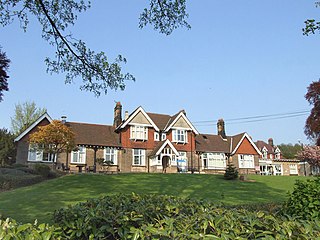
Whitworth Hospital is a healthcare facility on the Bakewell Road between Darley Dale and Matlock in Derbyshire, England. It is managed by Derbyshire Community Health Services NHS Foundation Trust.
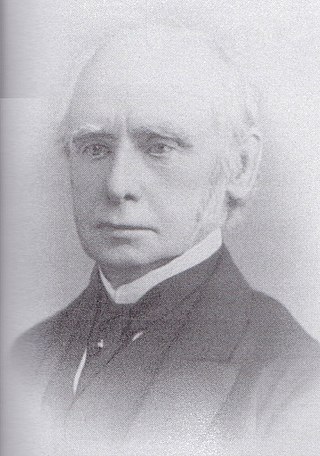
William Henry Robertson was an English physician and a leading figure behind the development of Buxton as a Victorian spa resort.

The Slopes is a Grade-II-listed public park in Buxton, Derbyshire in England. The area was laid out by landscape architect Jeffry Wyatville in 1811 for William Cavendish, 6th Duke of Devonshire, as pleasure grounds for the guests of The Crescent hotel to promenade. The design of The Terrace was modified further by Sir Joseph Paxton in 1859.
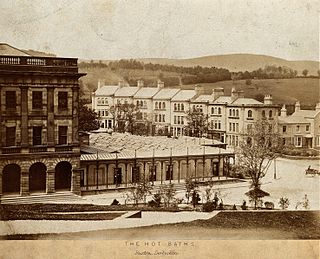
The Buxton Baths using natural thermal spring water are in Buxton, Derbyshire, England. The baths date back to Roman times and were the basis for developing Buxton as a Georgian and Victorian spa town. The present buildings of the Thermal Baths and the Natural Mineral Baths were opened in the 1850s. They are positioned either side of the Buxton Crescent at the foot of The Slopes in the town's Central Conservation Area. They are both Grade II listed buildings designed by Henry Currey, architect for the 7th Duke of Devonshire.
Buxton is a spa town in the High Peak district of Derbyshire, England. The town contains 93 listed buildings that are recorded in the National Heritage List for England. Of these, one is listed at Grade I, the highest of the three grades, seven are at Grade II*, the middle grade, and the others are at Grade II, the lowest grade. That the town was a source of natural water springs has been known at least since Roman times, and during the medieval period, St Ann's Well was a shrine and a place of pilgrimage. Buxton developed into a spa town during the 18th and 19th centuries, largely under the influence of the Dukes of Devonshire. The water was considered to have curative powers, and this led to the building of bath houses and later a hospital. Later, leisure facilities grew, and were served by the Pavilion Gardens, and the building of a conservatory, a theatre, a concert hall, and an opera house.

